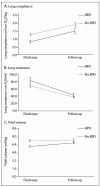Longitudinal assessment of the lung mechanics of very low birth weight preterm infants with and without bronchopulmonary dysplasia
- PMID: 26648428
- PMCID: PMC10871802
- DOI: 10.1590/1516-3180.2014.00101812
Longitudinal assessment of the lung mechanics of very low birth weight preterm infants with and without bronchopulmonary dysplasia
Abstract
Context and objective: Prematurity has been correlated with altered lung mechanics. Some infants develop lung injury as a consequence of lung immaturity, invasive mechanical ventilation and exposure to oxygen, thus resulting in bronchopulmonary dysplasia. The aim here was to compare the lung mechanics of preterm infants with and without bronchopulmonary dysplasia during the first year of life.
Design and setting: Prospective cohort study in a tertiary-level hospital.
Methods: This study included premature infants at a public hospital who underwent two pulmonary function tests: one at discharge and the other at the corrected age of 4 to 8 months. Tidal volume, lung compliance and lung resistance were measured. Statistical tests were used for comparisons between infants with and without bronchopulmonary dysplasia.
Results: 102 children with mean gestational age of 29 ± 2.0 weeks were studied; 17 with bronchopulmonary dysplasia. Lung compliance (0.84 ± 0.29 versus 1.28 ± 0.46; P < 0.001) and tidal volume (6.1 ± 0.94 versus 7.2 ± 1.43; P < 0.01) at discharge were significant lower in children with bronchopulmonary dysplasia than in those without the disease, but no differences were observed at the second test (compliance: 1.53 ± 0.77 versus 1.94 ± 1.01; P = 0.12; and tidal volume: 6.9 ± 1.4 versus 7.3 ± 1.6; P = 0.42).
Conclusion: Differences in lung mechanics were observed between infants with and without bronchopulmonary dysplasia at hospital discharge but these differences were no longer detected at the final follow-up. The lung mechanics of all the infants improved over this period of time.
CONTEXTO E OBJETIVO:: Prematuridade tem sido associada com mecânica pulmonar alterada. Algumas crianças desenvolvem lesão pulmonar como consequência de imaturidade pulmonar, ventilação mecânica invasiva e exposição a oxigênio, resultando em displasia broncopulmonar. O objetivo foi comparar a mecânica pulmonar de prematuros com e sem displasia broncopulmonar durante o primeiro ano de vida.
DESENHO DO ESTUDO E LOCAL:: Estudo de coorte prospectivo em um hospital terciário.
MÉTODOS:: O estudo incluiu prematuros, de hospital público, que realizaram duas provas de função pulmonar, uma na alta e outra entre quatro e oito meses de idade corrigida. Foram mensurados o volume corrente, a complacência e a resistência pulmonares. Testes estatísticos foram usados para comparações entre crianças com e sem displasia broncopulmonar.
RESULTADOS:: Foram estudadas 102 crianças com idade gestacional média de 29 ± 2 semanas; 17 com displasia broncopulmonar. A complacência pulmonar (0,84 ± 0,29 versus 1,28 ± 0,46; P < 0.001) e o volume corrente (6,1 ± 0,94 versus 7,2 ± 1,43; P < 0.01) na alta foram significativamente inferiores nas crianças com displasia broncopulmonar comparadas às crianças sem a doença, mas não foram observadas diferenças significativas no segundo teste (complacência: 1.53 ± 0.77 versus 1.94 ± 1.01; P = 0.12; e volume corrente: 6.9 ± 1.4 versus 7.3 ± 1.6; P = 0.42).
CONCLUSÃO:: Diferenças na mecânica pulmonar foram observadas entre crianças com e sem displasia broncopulmonar na alta hospitalar, mas essas diferenças não foram detectadas no seguimento final. A mecânica pulmonar de todas as crianças melhorou no decorrer desse período de tempo.
Conflict of interest statement
Figures
References
-
- Mosca F, Colnaghi M, Fumagalli M. BPD: old and new problems. J Matern Fetal Neonatal Med. 2011;24(1):80–82. - PubMed
-
- Broström EB, Thunqvist P, Adenfelt G, Borling E, Katz-Salamon M. Obstructive lung disease in children with mild to severe BPD. Respir Med. 2010;104(3):362–370. - PubMed
-
- Doyle LW, Faber B, Callanan C. Bronchopulmonary dysplasia in very low birth weight subjects and lung function in late adolescence. Pediatrics. 2006;118(1):108–113. - PubMed
Publication types
MeSH terms
LinkOut - more resources
Full Text Sources
Medical



